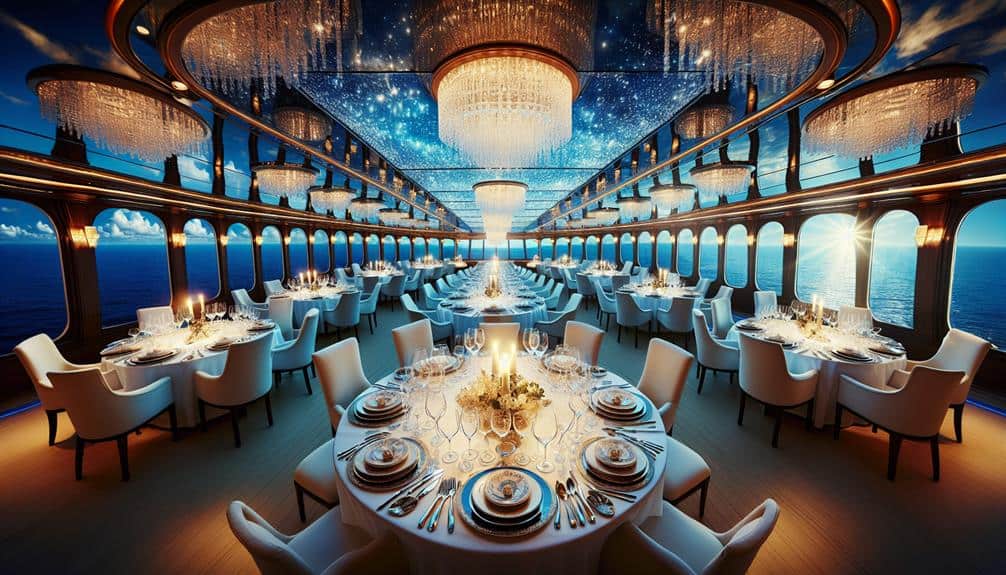Embark on an eco-conscious voyage with these sustainable design tips for cruise ship amenities. Opt for energy-efficient LED lighting, minimizing electricity use while considering renewable energy like solar panels. Focus on low-flow toilets and greywater recycling for water conservation, reducing waste and promoting efficiency. Choose eco-friendly materials like bamboo and reclaimed wood, sourced locally to lower emissions. Implement cutting-edge waste management systems and energy-efficient HVAC solutions to reduce environmental impact. Explore innovative technologies such as solar panels and geothermal heating for energy efficiency. Enhance passenger experience with sustainable landscaping practices. Revolutionize your travel experience with these eco-conscious tips.
Key Points
- Opt for energy-efficient LED fixtures to minimize electricity consumption.
- Focus on low-flow toilets and showers for water conservation.
- Choose sustainable materials like bamboo and reclaimed wood.
- Implement cutting-edge waste management systems for efficiency.
- Upgrade to energy-efficient HVAC systems to reduce environmental impact.
Efficient Lighting Solutions
When designing lighting solutions for cruise ship amenities, opt for energy-efficient LED fixtures to minimize electricity consumption and lower environmental impact. Energy-saving technology is an important aspect to keep in mind when aiming for sustainability onboard. LED fixtures not only reduce energy usage but also have a longer lifespan compared to traditional lighting options, making them a cost-effective choice in the long run. Incorporating renewable energy solutions, such as solar panels to power exterior lighting or common areas during the day, can further enhance the efficiency of the lighting system onboard.
Efficient lighting doesn't just mean using the right technology; it also involves strategic placement and controls. Utilize sensors and dimmers to adjust lighting levels based on natural light availability and occupancy. This not only saves energy but also creates a comfortable and welcoming ambiance for guests. By combining energy-saving technology with renewable energy solutions and smart controls, cruise ships can achieve a significant reduction in their overall electricity consumption while providing an excellent guest experience.
Water Conservation Strategies
When considering water conservation strategies for cruise ship amenities, focus on incorporating efficient plumbing fixtures like low-flow toilets and showers to reduce water usage.
Additionally, implementing greywater recycling systems can help repurpose water from sinks and showers for non-potable uses, further minimizing waste.
These innovative approaches not only conserve water but also contribute to a more sustainable and eco-conscious design for cruise ships.
Efficient Plumbing Fixtures
To optimize water conservation on cruise ships, consider implementing efficient plumbing fixtures that reduce water usage without compromising guest experience. Incorporating water-saving technology and smart design into the plumbing systems can greatly contribute to sustainable sanitation practices onboard.
By installing low-flow faucets, showers, and toilets, cruise ships can minimize water wastage while providing guests with a comfortable experience. Additionally, utilizing sustainable materials in the construction of these fixtures guarantees green solutions that align with environmentally conscious practices.
Efficient plumbing fixtures not only decrease water consumption but also showcase the cruise industry's dedication to eco-friendly initiatives. Prioritizing these innovative solutions in plumbing design can lead to substantial water savings without sacrificing the quality of amenities offered to passengers.
Greywater Recycling Systems
Consider implementing greywater recycling systems onboard cruise ships to enhance water conservation efforts and promote sustainable practices. Greywater recycling systems can substantially reduce water wastage by treating water from sinks, showers, and laundry for reuse in non-potable applications.
Here's how they contribute to green building and sustainable infrastructure:
- Reduced Water Demand: Greywater systems lessen the reliance on freshwater sources, decreasing the overall water demand on the ship.
- Energy Efficiency: By reusing greywater, cruise ships can lower energy consumption associated with treating and transporting freshwater.
- Environmental Impact: Implementing greywater recycling aligns with sustainable practices, reducing pollution and promoting eco-conscious operations.
Integrating such systems showcases a commitment to environmental stewardship and enhances the overall sustainability of cruise ship operations.
Eco-Friendly Material Choices
When choosing materials for cruise ship amenities, opt for sustainable options such as bamboo, cork, or reclaimed wood to reduce environmental impact. Select products with recycled content to minimize waste and promote a circular economy.
Source materials locally to lower carbon emissions associated with transportation and support regional economies.
Sustainable Material Options
Choose bamboo, a versatile and sustainable material option, to enhance the eco-friendliness of your cruise ship amenities. Bamboo is a fast-growing plant that can be harvested without causing harm to the environment, making it an excellent choice for eco-conscious design.
Here are some other sustainable material options to contemplate:
- Biodegradable Alternatives: Opt for materials that naturally break down over time, reducing waste and harm to the environment.
- Sustainable Furniture: Invest in furniture made from renewable resources to decrease the ecological footprint of your cruise ship amenities.
- Eco-Conscious Textiles: Choose fabrics that are produced using environmentally friendly practices, such as organic cotton or hemp, to promote sustainability in your design choices.
Recycled Content Selection
Enhance the sustainability of your cruise ship amenities by incorporating recycled content into your material selection. Opt for items that utilize upcycled decor, giving a new life to materials that would otherwise be discarded. Upcycled decor not only adds a unique touch to your amenities but also aligns with waste reduction initiatives, contributing to a greener environment.
Consider using items like upcycled wood for furniture, recycled glass for decorative elements, or repurposed textiles for upholstery. By incorporating recycled content into your design choices, you showcase a commitment to sustainability and responsible resource management, setting a new standard for eco-conscious cruise ship amenities.
Low-Impact Material Sourcing
In your quest for sustainable cruise ship amenities, explore the domain of low-impact material sourcing, where eco-friendly material choices pave the way for innovative and environmentally conscious design solutions. When selecting materials for your cruise ship amenities, consider the following:
- Eco-Friendly Furniture: Opt for furniture made from sustainable materials like bamboo, reclaimed wood, or recycled plastic to reduce environmental impact and promote a circular economy.
- Carbon Offsetting Initiatives: Implement carbon offsetting programs to neutralize the emissions produced during the manufacturing and transportation of materials, contributing to a more sustainable operation.
- Biodegradable Materials: Choose biodegradable options for items like disposable cutlery, cups, and packaging to minimize waste and support a greener approach to hospitality.
Innovative Waste Management Systems
To revolutionize waste management on cruise ships, consider implementing cutting-edge technologies that prioritize sustainability and efficiency. Waste reduction strategies play an essential role in minimizing the environmental impact of cruise ship operations. Implementing innovative recycling methods such as advanced sorting systems and onboard composting can greatly reduce the amount of waste sent to landfills. Green technology solutions like waste-to-energy systems can convert organic waste into renewable energy, further enhancing sustainability efforts onboard.
Eco-conscious disposal practices, such as utilizing biodigesters to break down food waste or installing water treatment systems to purify wastewater before discharge, are vital for maintaining the pristine marine environment. Separating and recycling materials like glass, plastic, and paper onboard can also contribute to resource conservation and reduce the need for virgin materials.
Energy-Efficient HVAC Systems
Consider upgrading the cruise ship's HVAC systems to energy-efficient models that prioritize sustainability and reduce environmental impact while enhancing onboard comfort. By implementing cutting-edge technologies, you can notably decrease energy consumption and greenhouse gas emissions.
- Incorporate Solar Panels: Install solar panels on the cruise ship's deck to harness energy from the sun, reducing the reliance on traditional power sources and lowering energy costs.
- Utilize Geothermal Heating: Implement geothermal heating systems that tap into the Earth's natural heat, providing efficient heating and cooling for the ship while minimizing energy usage and emissions.
- Opt for Energy Recovery Ventilation: Energy recovery ventilation systems recycle heat from outgoing air to condition incoming air, improving indoor air quality and reducing the workload on HVAC systems.
Greenhouse Gas Emission Reduction
Reduce greenhouse gas emissions by implementing advanced emission control technologies that optimize engine performance while minimizing environmental impact on the cruise ship. Utilizing renewable energy sources such as solar panels or wind turbines can substantially reduce the reliance on traditional fossil fuels, thereby decreasing carbon emissions. Incorporating carbon offsetting programs into the cruise ship's operations can also help neutralize emissions that are challenging to eliminate entirely.
When considering greenhouse gas emission reduction, it's essential to focus on the efficiency of the ship's systems. Regular maintenance and tuning of engines, along with the use of high-quality fuels, can enhance performance while lowering emissions. Investing in innovative technologies like exhaust gas cleaning systems can further reduce pollutants released into the atmosphere.
Sustainable Landscaping Practices
Implement sustainable landscaping practices onboard the cruise ship to create environmentally friendly outdoor spaces that enhance passenger experience while minimizing ecological impact. When designing the outdoor areas, consider incorporating native plantings and green roofs to promote biodiversity and energy efficiency.
- Native Plantings: Utilize native plants in landscaping to reduce water consumption, minimize the need for pesticides, and support local wildlife populations. Native plants are adapted to the region's climate and soil conditions, requiring less maintenance and resources compared to non-native species.
- Green Roofs: Integrate green roofs on deck areas to enhance insulation, reduce heat absorption, and capture rainwater for reuse in irrigation systems. Green roofs not only provide natural insulation, lowering energy costs for cooling, but also create additional green spaces for passengers to enjoy.
- Sustainable Irrigation: Implement smart irrigation systems that use sensors to monitor soil moisture levels and adjust watering schedules accordingly. By reducing water waste and ensuring plants receive just the right amount of water, sustainable irrigation practices can contribute to overall water conservation efforts onboard.
Frequently Asked Questions
How Can Cruise Ship Amenities Be Designed to Minimize Their Impact on Marine Ecosystems?
To minimize impact on marine ecosystems with cruise ship amenities, use eco-friendly materials like recycled plastics and sustainably sourced wood. Implement marine conservation efforts by reducing single-use plastics, promoting responsible waste management, and supporting local marine protection initiatives.
What Are Some Innovative Ways to Incorporate Renewable Energy Sources Into the Design of Cruise Ship Amenities?
To make cruise ship amenities sustainable, consider solar powered spas, wind turbine pools, hydroelectric gyms, and biomass saunas. Embrace renewable energy sources creatively for a greener voyage. Sail towards innovation and eco-conscious design.
Are There Any Specific Regulations or Certifications That Cruise Ship Amenities Should Adhere to in Order to Be Considered Sustainable?
To guarantee sustainability, adhere to regulations and certifications for cruise ship amenities. They direct your environmental impact, supporting your sustainability efforts. Seek out certifications like Green Marine or Blue Flag to showcase your commitment to eco-conscious practices.
How Can Cruise Ship Amenities Be Designed to Promote Biodiversity and Support Local Wildlife?
Want to make your cruise ship amenities a haven for local wildlife? Start by using eco-friendly materials, creating green spaces on board, and partnering with conservation organizations. Promoting biodiversity can be a luxurious adventure!
What Are Some Ways That Cruise Ship Amenities Can Engage Passengers in Sustainability Efforts During Their Travels?
Engaging passengers in sustainability initiatives during travels involves offering eco-friendly amenities and encouraging guest involvement. By providing interactive experiences, educational programs, and opportunities for hands-on participation, cruise ships can empower passengers to support environmental efforts.




